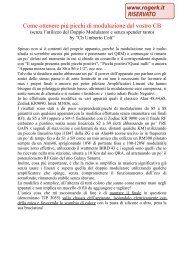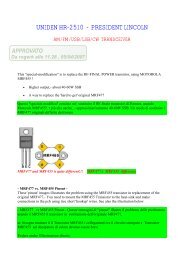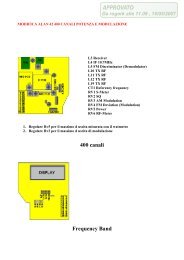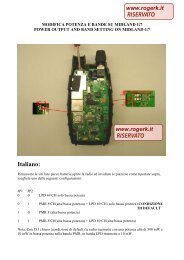Modifications for the ICOM - RogerK
Modifications for the ICOM - RogerK
Modifications for the ICOM - RogerK
- No tags were found...
Create successful ePaper yourself
Turn your PDF publications into a flip-book with our unique Google optimized e-Paper software.
1. C231 from 1000 pf to 68 pf.2. C232 from .01 uf to 1000 pf. (You can use <strong>the</strong> capacitor which used to be C231.)3. C234 from 100 pf to 22 pf.4. C236 from 47 pf to 22 pf.5. C237 from 680 pf to 100 pf. (You can use <strong>the</strong> capacitor which used to be C234.)Solder a 10 microhenry inductor in parallel with L204, a 20 microhenry inductor.Changes <strong>for</strong> BS-8 ModuleI haven't tried <strong>the</strong> BS-8 module, but encourage you to try using it as is, without modification unless neces- sary.These steps are needed only if you cannot find settings of <strong>the</strong> side mounted aligment controls that get <strong>the</strong> display to behave asspecified in <strong>the</strong> owner's manual:1. Remove C233, <strong>the</strong> 33 pf disc capacitor, from <strong>the</strong> printed circuit board.2. Replace coil L204, <strong>the</strong> 4.7 microhenry inductor, with a 6 or 7 microhenry inductor.AlignmentFollow <strong>the</strong> alignment procedure in <strong>the</strong> SM-220 owner's manual to adjust <strong>the</strong> panadaptor. This consists of adjusting 2potentiometers and 1 trimmer capacitor through holes thoughtfully provided in <strong>the</strong> side of <strong>the</strong> cabinet.The alignment instructions rely on <strong>the</strong> use of <strong>the</strong> internal Marker Generator to generate a signal at <strong>the</strong> center of <strong>the</strong> passband. Ifyou haven't converted <strong>the</strong> Marker Generator circuit, you can tune your receiver to a frequency with a signal present at a knownfrequency (like 162.550 MHz - <strong>the</strong> National Wea<strong>the</strong>r Service), and use that as a frequency standard.Most of <strong>the</strong> time spent in aligment will be in alternate adjustments between <strong>the</strong> trimmer capacitor and <strong>the</strong> wide band sweeppotentiometer, which interact with each o<strong>the</strong>r.Wider BandwidthThe SCAN WIDTH switch on <strong>the</strong> stock SM-220 can be set to display a 40 KHz or a 200 KHz wide picture. I adjusted my modifiedSM-220 to display a 100 KHz or a 500 KHz wide picture. By adjusting <strong>the</strong> controls on <strong>the</strong> side of <strong>the</strong> SM-220, wider bandwidthsare possible, but wider bandwidths make it more difficult to resolve individual signals close to each o<strong>the</strong>r in frequency. As <strong>the</strong>bandwidth gets wider, <strong>the</strong> horizontal sweep loses linearity, causing <strong>the</strong> graticule calibration lines to be inaccurate.Connection to R-7000As mentioned earlier, a DC voltage is present at <strong>the</strong> R-7000 IF output connector and is used to power an <strong>ICOM</strong> TV accessory. Adirect connection between <strong>the</strong> R-7000 IF output connector and SM-220 would damage at least one of <strong>the</strong>se units.To block <strong>the</strong> DC voltage, a 0.1 microfarad capacitor was soldered inside <strong>the</strong> R-7000, between <strong>the</strong> IF output jack and <strong>the</strong> adjacentjack labeled "spare". Connection between <strong>the</strong> R-7000 and SM-220 is <strong>the</strong>n made using a short length of RG-58/U coaxial cable,with one end plugged into <strong>the</strong> R-7000 "spare" jack, and <strong>the</strong> o<strong>the</strong>r end plugged into <strong>the</strong> rear of <strong>the</strong> SM-220.This leaves <strong>the</strong> original IF output jack undisturbed so it can be used with <strong>the</strong> TV adaptor accessory.Vertical SensitivityWhen I connected my modified SM-220 to my R7000, <strong>the</strong> SM-220 would display only <strong>the</strong> strongest of signals. To improve <strong>the</strong>display sensitivity, I inserted a 20 dB gain RF amplifier between <strong>the</strong> R7000 and SM-220. The amplifier was a spare Ameco PLF2FET receiver preamp, adjusted <strong>for</strong> 10.7 MHz, but o<strong>the</strong>r amplifiers can be used, provided <strong>the</strong>y have at least a 500 KHz bandwidth,and sufficient gain, at 10.7 MHz.False Readings - ImagesThe SM-220 circuit is like a superheterodyne receiver. The panadaptor itself has a 455 KHz IF, and like o<strong>the</strong>r superheterodynereceivers with a low IF frequency, is prone to images.An image is manifested as a false pip, which moves across <strong>the</strong> screen as <strong>the</strong> receiver is tuned, and is 910 KHz (twice <strong>the</strong> IF)away from <strong>the</strong> actual signal.The images discussed here are in <strong>the</strong> SM-220, not in <strong>the</strong> receiver. Images are bo<strong>the</strong>rsome on <strong>the</strong> strongest sig- nals, like those300 watt paging transmitters that saturate <strong>the</strong> county with RF, belching out out strange digital noises or voices (now illegal tomonitor).Use With O<strong>the</strong>r ReceiversThe modified SM-220 can be used with o<strong>the</strong>r receivers having a 10.7 MHz IF. In o<strong>the</strong>r receivers, one would need to find <strong>the</strong>










